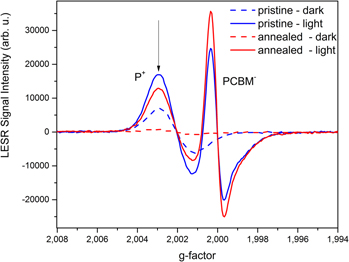Crossref Citations
This article has been cited by the following publications. This list is generated based on data provided by
Crossref.
Biskup, Till
2019.
Structure–Function Relationship of Organic Semiconductors: Detailed Insights From Time-Resolved EPR Spectroscopy.
Frontiers in Chemistry,
Vol. 7,
Issue. ,
Watts, Kristen E.
Nguyen, Trung
Tremolet de Villers, Bertrand J.
Neelamraju, Bharati
Anderson, Michael A.
Braunecker, Wade A.
Ferguson, Andrew J.
Larsen, Ross E.
Larson, Bryon W.
Owczarczyk, Zbyslaw R.
Pfeilsticker, Jason R.
Pemberton, Jeanne E.
and
Ratcliff, Erin L.
2019.
Stability of push–pull small molecule donors for organic photovoltaics: spectroscopic degradation of acceptor endcaps on benzo[1,2-b:4,5-b′]dithiophene cores.
Journal of Materials Chemistry A,
Vol. 7,
Issue. 34,
p.
19984.
Yan, Lingpeng
Wang, Yaling
Wei, Junfeng
Ji, Guoqi
Gu, Huimin
Li, Zerui
Zhang, Jianqi
Luo, Qun
Wang, Zhongqiang
Liu, Xuguang
Xu, Bingshe
Wei, Zhixiang
and
Ma, Chang-Qi
2019.
Simultaneous performance and stability improvement of polymer:fullerene solar cells by doping with piperazine.
Journal of Materials Chemistry A,
Vol. 7,
Issue. 12,
p.
7099.
Araújo, F.L.
Amorim, D.R.B.
Torres, B.B.M
Coutinho, D.J.
and
Faria, R.M.
2020.
Electrical performance of PTB7-Th:PC71BM solar cell when in contact with the environment.
Solar Energy,
Vol. 208,
Issue. ,
p.
583.
Gu, Huimin
Yan, Lingpeng
Saxena, Sonam
Shi, Xueliang
Zhang, Xuning
Li, Zerui
Luo, Qun
Zhou, Huiqiong
Yang, Yongzhen
Liu, Xuguang
Wong, Wallace W. H.
and
Ma, Chang-Qi
2020.
Revealing the Interfacial Photoreduction of MoO3 with P3HT from the Molecular Weight-Dependent “Burn-In” Degradation of P3HT:PC61BM Solar Cells.
ACS Applied Energy Materials,
Vol. 3,
Issue. 10,
p.
9714.
Li, Zerui
Shan, Jiankai
Yan, Lingpeng
Gu, Huimin
Lin, Yi
Tan, Hongwei
and
Ma, Chang-Qi
2020.
The Role of the Hydrogen Bond between Piperazine and Fullerene Molecules in Stabilizing Polymer:Fullerene Solar Cell Performance.
ACS Applied Materials & Interfaces,
Vol. 12,
Issue. 13,
p.
15472.
Li, Zerui
Yan, Lingpeng
Shan, Jiankai
Gu, Huimin
Lin, Yi
Wang, Yaling
Tan, Hongwei
and
Ma, Chang-Qi
2020.
Organic Amines as Targeting Stabilizer at the Polymer/Fullerene Interface for Polymer:PC61BM Solar Cells.
Energy Technology,
Vol. 8,
Issue. 12,
Martynov, Ilya V.
Inasaridze, Liana N.
and
Troshin., Pavel A.
2022.
Resist or Oxidize: Identifying Molecular Structure–Photostability Relationships for Conjugated Polymers Used in Organic Solar Cells.
ChemSusChem,
Vol. 15,
Issue. 3,
Choi, Yelim
Park, Sang Ah
Bae, Yurim
Kim, Dohyun
Kim, Minjun
and
Park, Taiho
2023.
A Facile Method for Thermally, Light, and Mechanically Stable Organic Solar Cells Using Ultraviolet‐Initiated Crosslinkable Additive.
Advanced Optical Materials,
Vol. 11,
Issue. 2,
Mazzolini, Eva
Qiao, Zhuoran
Muller, Jolanda
Furlan, Francesco
Sanviti, Matteo
Nodari, Davide
Rimmele, Martina
Collauto, Alberto
Deibel, Carsten
Heeney, Martin
Martin, Jaime
Eisner, Flurin
Nelson, Jenny
Gasparini, Nicola
and
Panidi, Julianna
2025.
Discerning Blend Microstructure and Charge Recombination for Stable Biorenewable‐Based Organic Photovoltaics.
Advanced Energy Materials,
Iyer, Raghunandan B.
Higgins, Maurissa
Noack, Katelyn
Wolanyk, Joshua
Dygert, Matthew
Cady, Sarah
Dykstra, Erik
Biswas, Rana
Shinar, Ruth
and
Shinar, Joseph
2025.
Kinetics of photogenerated carbon dangling bonds in organic photovoltaic thin Films: An EPR study.
Organic Electronics,
Vol. 144,
Issue. ,
p.
107269.
